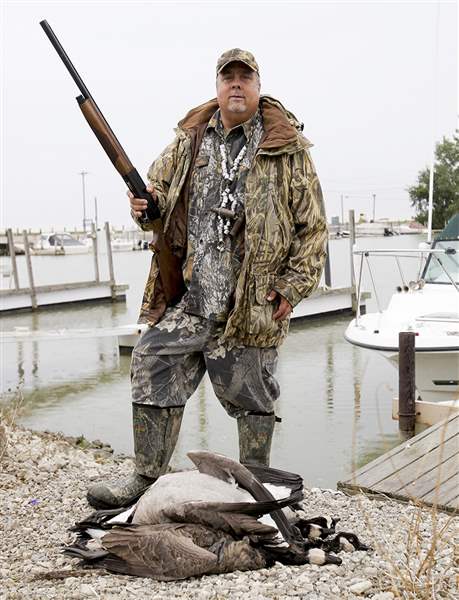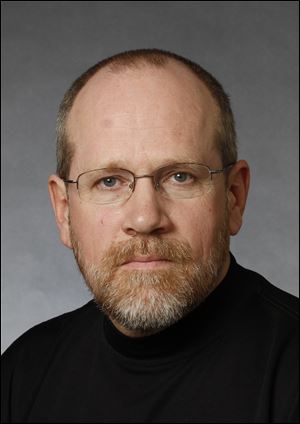
Commentary
Waterfowl hunting part of Toledoan’s DNA
10/6/2013
Toledo outdoorsman Mike McCroskey displays geese he shot during the early goose season in September. He has been guiding hunts for more than 30 years.
THE BLADE/JEFFREY SMITH
Buy This Image

Matt Markey.
When the fall hunting seasons approach, Mike McCroskey gets overcome by an antsy, unsettled feeling. He’s not sure just where it comes from, but he knows exactly what it means.

Toledo outdoorsman Mike McCroskey displays geese he shot during the early goose season in September. He has been guiding hunts for more than 30 years.
“I hunt because I must hunt,” the great-grandson of a Cherokee chief says. “My wife doesn’t understand it, and maybe it’s something in my genes. But it is definitely there – it’s real. When it’s hunting season, I must go.”
McCroskey will hunt the tree lines and the woodlots for white-tailed deer, but it’s in the marshes and fields where he spends the most time. Hunting geese and ducks is his passion.
Ohio’s waterfowl hunting season along Lake Erie opens Saturday, and McCroskey expects to be tucked into his hunting blind well before dawn, ready to greet the first dots in the sky as daylight approaches.
“It is a spiritual thing. It is about the tradition of hunting these marshes,” he said.
McCroskey, who grew up on Corduroy Road in Oregon, has been close to those watery grasslands since he was a kid. He now leases properties near the Ottawa National Wildlife Refuge and Magee Marsh Wildlife Area and takes advantage of every opportunity to hunt geese and ducks there.
“There is just something so special, so unique about seeing the seasons change and then watching those geese and ducks come in,” he said. “They come in almost as if they are from another planet. You feel that northwest wind hit you like a breath of fresh air, and you always know the birds were coming.”
The 53-year-old auto worker and DeVilbiss graduate said that despite his hundreds of trips to the fields along the lake, he still is in awe of the birds that frequent the area, and give it the reputation as one of the premier waterfowl hunting locations in this part of the country.
“I love these birds, and I know that makes this such a paradox — how can I kill something I love so much,” he said. “But nothing goes to waste; every bird ends up on the table, feeding my family. There’s a long-standing tradition of hunting and bringing food home to your family. I follow that tradition.”
McCroskey keeps his hunting blind on skids, so it can be moved around the fields as the grain harvests continue. He likes to work along the wheat fields in September, the beans in October, and the corn in November and December.
He uses decoys and a call to bring geese and ducks in, but said that in between flights of waterfowl coming to the fields to feed, he and his hunting partners get to enjoy the many songbirds in the area, a kingfisher swooping down to grab a meal, raccoons pawing at the bank looking for crayfish, or a coyote casting a wary eye toward the decoys.
“There’s really something spiritual about being out there, and the tradition of the duck hunts here,” he said. “And I think about all the great duck hunters I’ve known that have passed away. I still feel them out there, and on the days when the geese come easy, I can see their faces in the stars when we’re sitting in the blind before dawn.”
Former University of Toledo head football coach Tom Amstutz is an avid waterfowl hunter, and he has made numerous trips to those hunting grounds near the lake with McCroskey over the last seven years.
“With Mike, it’s not about just going out and shooting: It’s the whole experience, the stories, and an appreciation for the atmosphere and the surroundings; that’s what I enjoy about it,” Amstutz said. “There’s a real peaceful feeling he has in the blind.”
The pair took advantage of Ohio’s special early goose season in the first two weeks of September, with McCroskey successfully calling in numerous Canada geese.
“He’s very good at it, but what I like most is that he is also very passionate about this,” Amstutz said. “You want to be truly involved in whatever you do, because it makes life richer, and Mike certainly is that way. Hunting with him, you get the complete experience.”
McCroskey, who has guided waterfowl hunts for 30 years and is also a licensed charter fishing captain, said he wishes more waterfowl hunters would become engaged in all of the elements of the sport.
“Most people never see all of the other things that are going on out there,” he said. “It’s about so much more than how many ducks you kill. If you truly love this whole experience, then the numbers shouldn’t matter. But unfortunately, a lot of guys never reach that stage in their career when the numbers don’t matter.”
McCroskey starts his charter fishing operation very early in the spring, right after the ice comes off, when big walleye are staging for the spawning period. He is also introducing a late summer/early fall combination outing he calls “Ohio Surf & Turf”, where the morning is spent hunting geese near the marshes, and the afternoon spent out on the lake pursuing jumbo perch.
But it is always the waterfowl hunt that really gets his blood flowing.
“I guess I’m like a hunting dog — when it’s the season, I must go,” he said. “It’s a deep and instinctive kind of thing. For thousands of years, our ancestors were hunters and gatherers, and maybe this is how I connect with the past. I don’t know what it is for sure, but I just know this — when it is hunting season, I feel this force inside me. I have to go.”
Contact Blade outdoors editor Matt Markey at: mmarkey@theblade.com or 419-724-6068.